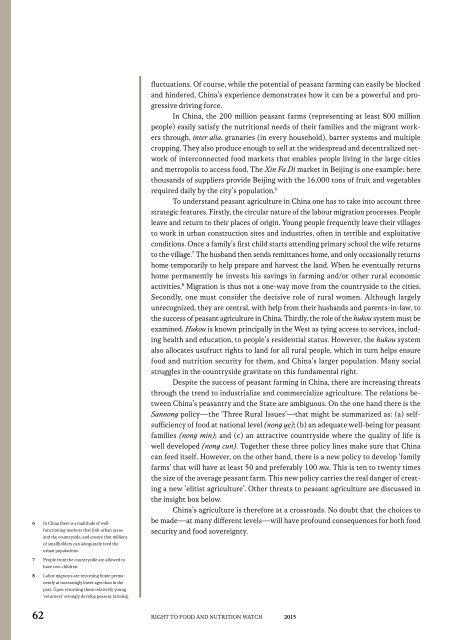RIGHT TO FOOD AND NUTRITION WATCH
1iNBHTY
1iNBHTY
You also want an ePaper? Increase the reach of your titles
YUMPU automatically turns print PDFs into web optimized ePapers that Google loves.
6 In China there is a multitude of wellfunctioning<br />
markets that link urban areas<br />
and the countryside, and ensure that millions<br />
of smallholders can adequately feed the<br />
urban populations.<br />
7 People from the countryside are allowed to<br />
have two children.<br />
8 Labor migrants are returning home permanently<br />
at increasingly lower ages than in the<br />
past. Upon returning these relatively young<br />
‘returners’ strongly develop peasant farming.<br />
62<br />
fluctuations. Of course, while the potential of peasant farming can easily be blocked<br />
and hindered, China’s experience demonstrates how it can be a powerful and progressive<br />
driving force.<br />
In China, the 200 million peasant farms (representing at least 800 million<br />
people) easily satisfy the nutritional needs of their families and the migrant workers<br />
through, inter alia, granaries (in every household), barter systems and multiple<br />
cropping. They also produce enough to sell at the widespread and decentralized network<br />
of interconnected food markets that enables people living in the large cities<br />
and metropolis to access food. The Xin Fa Di market in Beijing is one example: here<br />
thousands of suppliers provide Beijing with the 16,000 tons of fruit and vegetables<br />
required daily by the city’s population. 6<br />
To understand peasant agriculture in China one has to take into account three<br />
strategic features. Firstly, the circular nature of the labour migration processes. People<br />
leave and return to their places of origin. Young people frequently leave their villages<br />
to work in urban construction sites and industries, often in terrible and exploitative<br />
conditions. Once a family’s first child starts attending primary school the wife returns<br />
to the village. 7 The husband then sends remittances home, and only occasionally returns<br />
home temporarily to help prepare and harvest the land. When he eventually returns<br />
home permanently he invests his savings in farming and/or other rural economic<br />
activities. 8 Migration is thus not a one-way move from the countryside to the cities.<br />
Secondly, one must consider the decisive role of rural women. Although largely<br />
unrecognized, they are central, with help from their husbands and parents-in-law, to<br />
the success of peasant agriculture in China. Thirdly, the role of the hukou system must be<br />
examined. Hukou is known principally in the West as tying access to services, including<br />
health and education, to people’s residential status. However, the hukou system<br />
also allocates usufruct rights to land for all rural people, which in turn helps ensure<br />
food and nutrition security for them, and China’s larger population. Many social<br />
struggles in the countryside gravitate on this fundamental right.<br />
Despite the success of peasant farming in China, there are increasing threats<br />
through the trend to industrialize and commercialize agriculture. The relations between<br />
China’s peasantry and the State are ambiguous. On the one hand there is the<br />
Sannong policy—the ‘Three Rural Issues’—that might be summarized as: (a) selfsufficiency<br />
of food at national level (nong ye); (b) an adequate well-being for peasant<br />
families (nong min); and (c) an attractive countryside where the quality of life is<br />
well developed (nong cun). Together these three policy lines make sure that China<br />
can feed itself. However, on the other hand, there is a new policy to develop ‘family<br />
farms’ that will have at least 50 and preferably 100 mu. This is ten to twenty times<br />
the size of the average peasant farm. This new policy carries the real danger of creating<br />
a new ‘elitist agriculture’. Other threats to peasant agriculture are discussed in<br />
the insight box below.<br />
China’s agriculture is therefore at a crossroads. No doubt that the choices to<br />
be made—at many different levels—will have profound consequences for both food<br />
security and food sovereignty.<br />
<strong>RIGHT</strong> <strong>TO</strong> <strong>FOOD</strong> <strong>AND</strong> <strong>NUTRITION</strong> <strong>WATCH</strong> 2015


